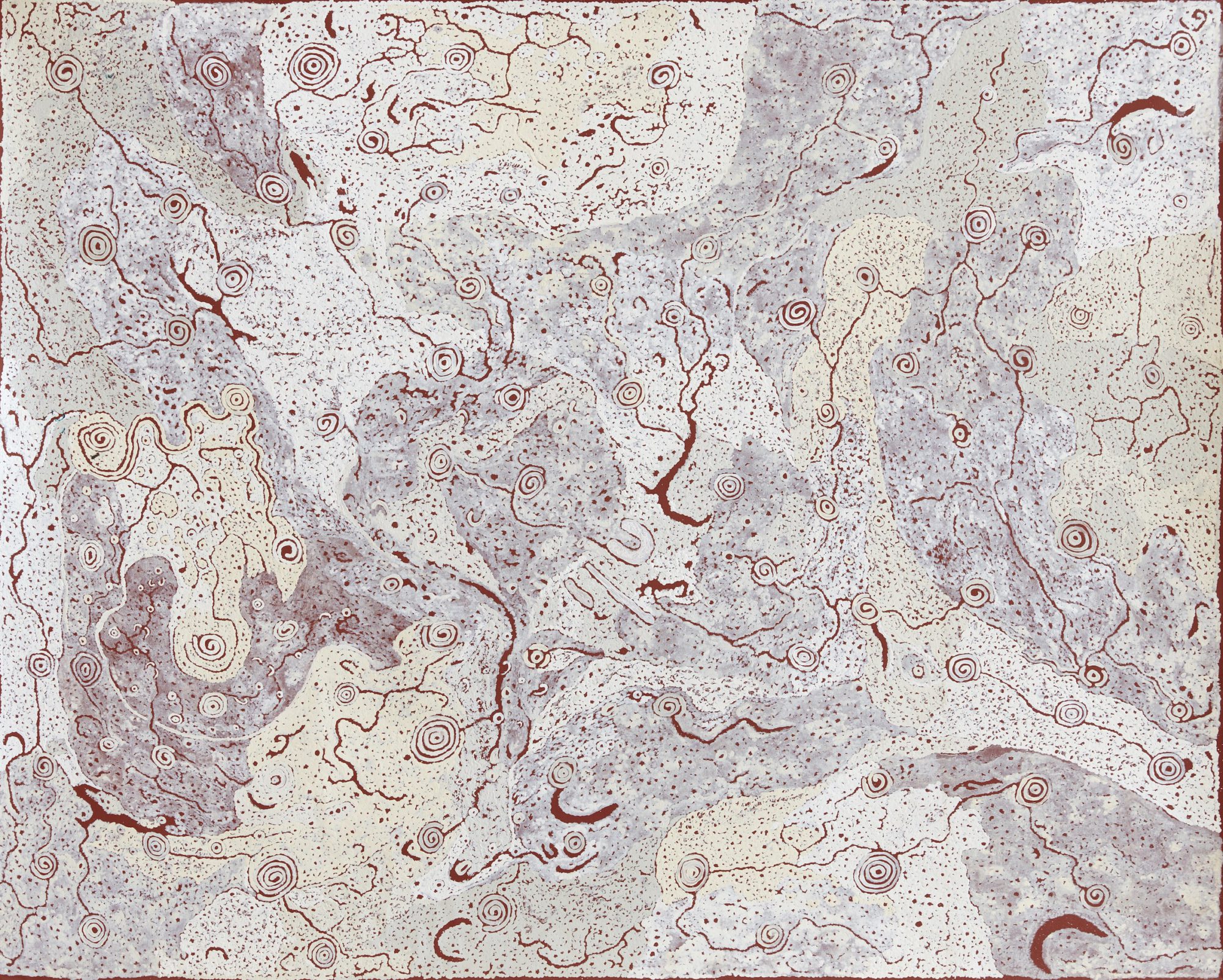
Exhibition Essay
Keith Stevens is a Pitjantjatjara artist born in the far north of South Australia at Granite Downs cattle station where his parents were working in the 1940s.
Following in his parents’ footsteps he was mustering at an early age and had no schooling until moving to Pukatja (Ernabella) as a young boy where he attended the mission school. Keith’s family would travel for weekends to their traditional homelands of Piltati and Iwarrawarra, eventually moving to Piltati creek at what is now Nyapari Community, where Keith currently resides.
Keith is a respected senior man in traditional law and a strong community leader. He comes from an artistic family: his mother Kunmanara (Eileen Yaritja) Stevens and his uncles Kunmanara (Tiger) Palpatja and Ginger Wikilyiri are well known for their depictions of Piltati, the location of the major ancestral narrative for Nyapari, the Wanampi Tjukurpa (Rainbow Snake Ancestral Men Dreaming).
Keith Stevens’s ancestral homelands provide the platform for human and other dramas as rich and monumental in scale as any conceived by Shakespeare, Molière or for that matter, the creators of great Indian epics like The Ramayana.
That Stevens conceives these epics in dramatically visual terms crystallizes their intensity. Here, in his artwork, we can observe the full range of Ancestral and human activity and behaviour, from benign to malevolent and everything in-between.
Piltati is also the site of the grand narrative of two brothers who are married to two sisters – the Wati Kutjara (Two Men) and Minyma Kutjara (Two Women). Yet these two ancestral men are in fact classic Indigenous ‘trickster’ figures. Monstrous and exceedingly dangerous, Wanampi (Rainbow Serpents or Rainbow Snakes) are said to have the capacity to manifest themselves on the earth not only in human form but also to make themselves invisible, living in waterholes and rockholes jealously guarding those precious water sources. The two Wanampi brothers live in the rockhole at Piltati:
Wati kutjara nyinanyi kunkunpa. [The two men are sitting down sleeping]. They have been painting inside the cave. When they wake up they start looking for the two women. They turn into Wanampi to trick the women and hide in the hole the women have been digging.
This narrative relates to these Ancestral Men behaving badly. Their engagement in deception, sloth, and exploitation of women during the Tjukurpa possesses all the elements of high drama. In other sequences of the same narrative the sisters retaliate by eating all the food that they have collected without sharing any with their husbands. In response, the Two Snake Men demonstrate their cannibalistic qualities by swiftly devouring the two sisters to whom they are married.
In Keith Stevens’s Piltati, he paints the story from the perspective of the two women:
They sit around their campsite patiently and when the time is right they go out searching for the kuka pulka (big game). As they search the women come across the tracks of a large snake that could feed them well, little do they know these tracks have been drawn in the sand by two men to trick the women. The men have used their miru (spear throwers) to make tracks that look like a big snake. The Wanampi men (water-snake men) are cunning, they leave a trail of kuka kulupa (little bits of meat) to keep the women chasing. The women think they are getting close, but they only ever find small pieces of meat. They become confused. One day they are digging along the track, they dig one hole…nothing, they dig a second hole…nothing, they dig a third and fourth hole and finally while they are digging the fifth hole they uncover two men asleep. The men are in a deep slumber, snoring loudly. The women become wild with anger when they realize they have been tricked by the Wanampi men. While the men are still sleeping, one woman takes her wana (digging stick) and strikes one of the men on his back. The man wakes up in pain and sees the woman running away. He chases her, devours her and drags her back into the Piltati rockhole, the Wanampiku ngura (water-snake resting place/home). The Wanampi is always surrounded by water. He belongs to water, water belongs to him.[1]
Despite Piltati being a beautiful fertile place, an oasis, a rock hole that never runs dry, a lifesaving destination, Stevens has chosen the palette of ash as you would see in a semi dormant campfire. The subtlety of tones accentuates the changes in the landscape. This is a major shift from his preference for deep papal colours of the past. As a body of work, it marks a new refinement in his practice
With thanks to Dr Christine Nicholls for permission to use some text that originally appeared in the exhibition catalogue for Keith Stevens’s mother’s solo exhibition Eileen Yaritja Stevens: Minyma Kutju – One Woman.
[1] Documentation story for Keith Stevens Piltati 2019




